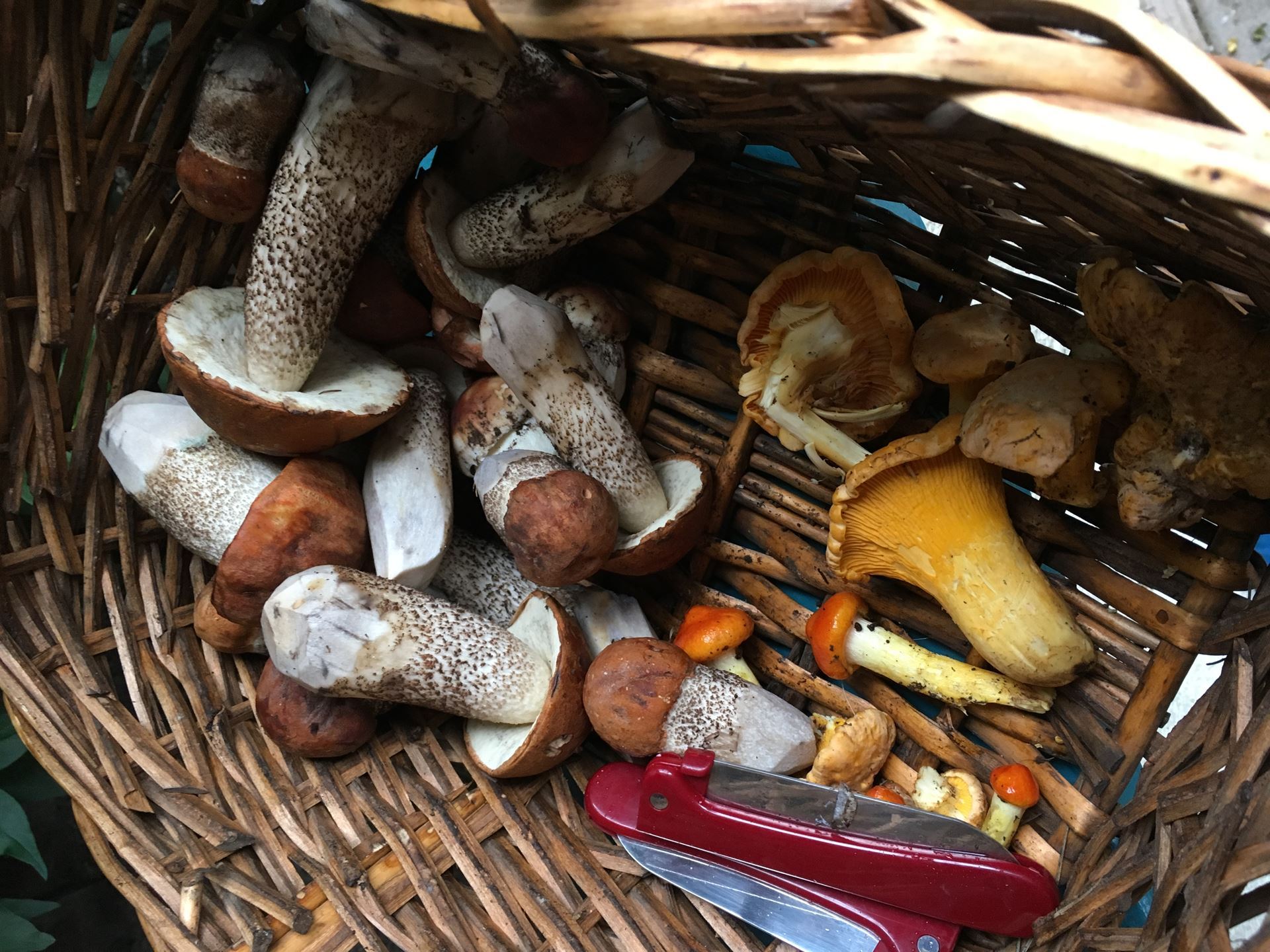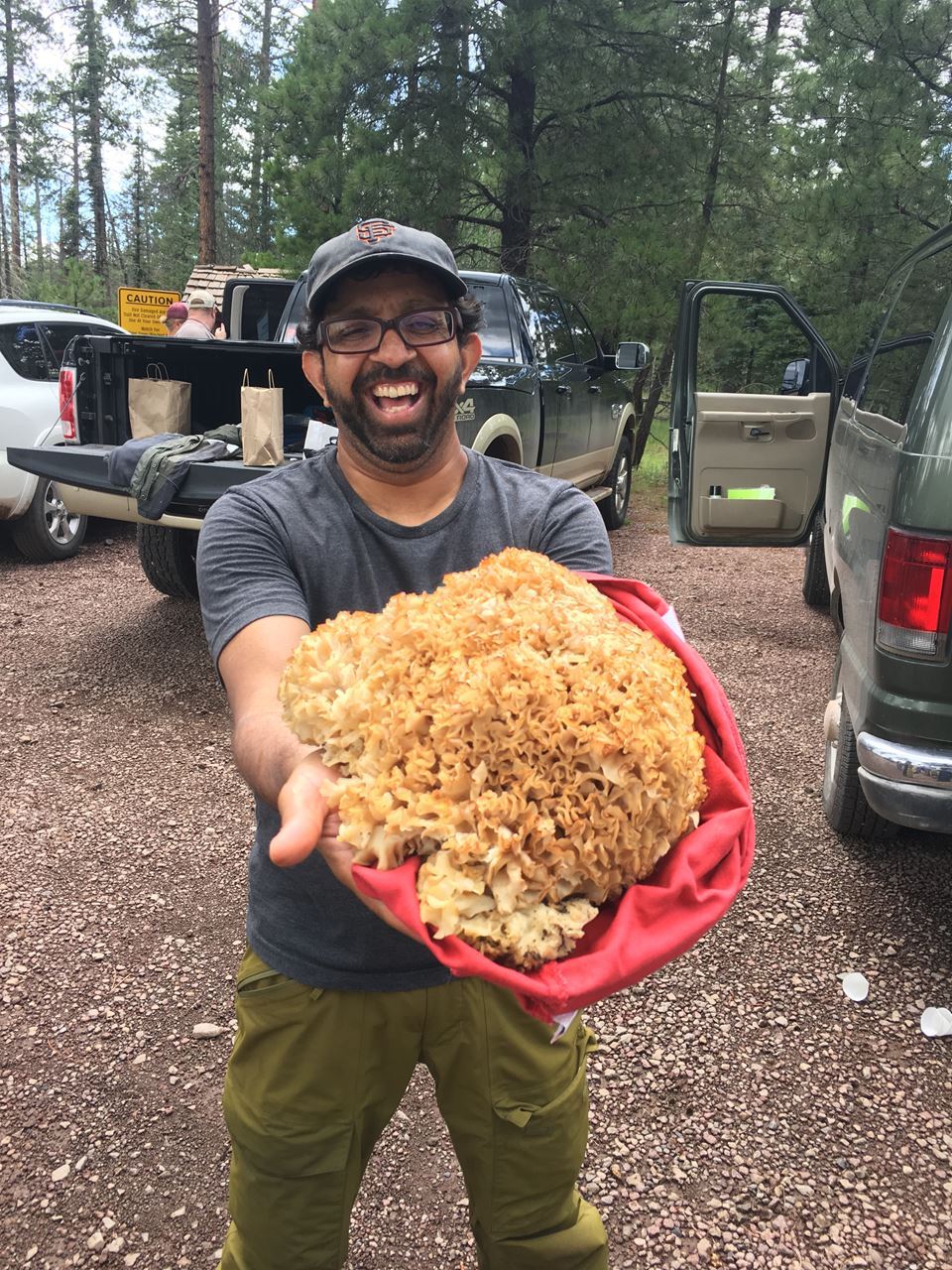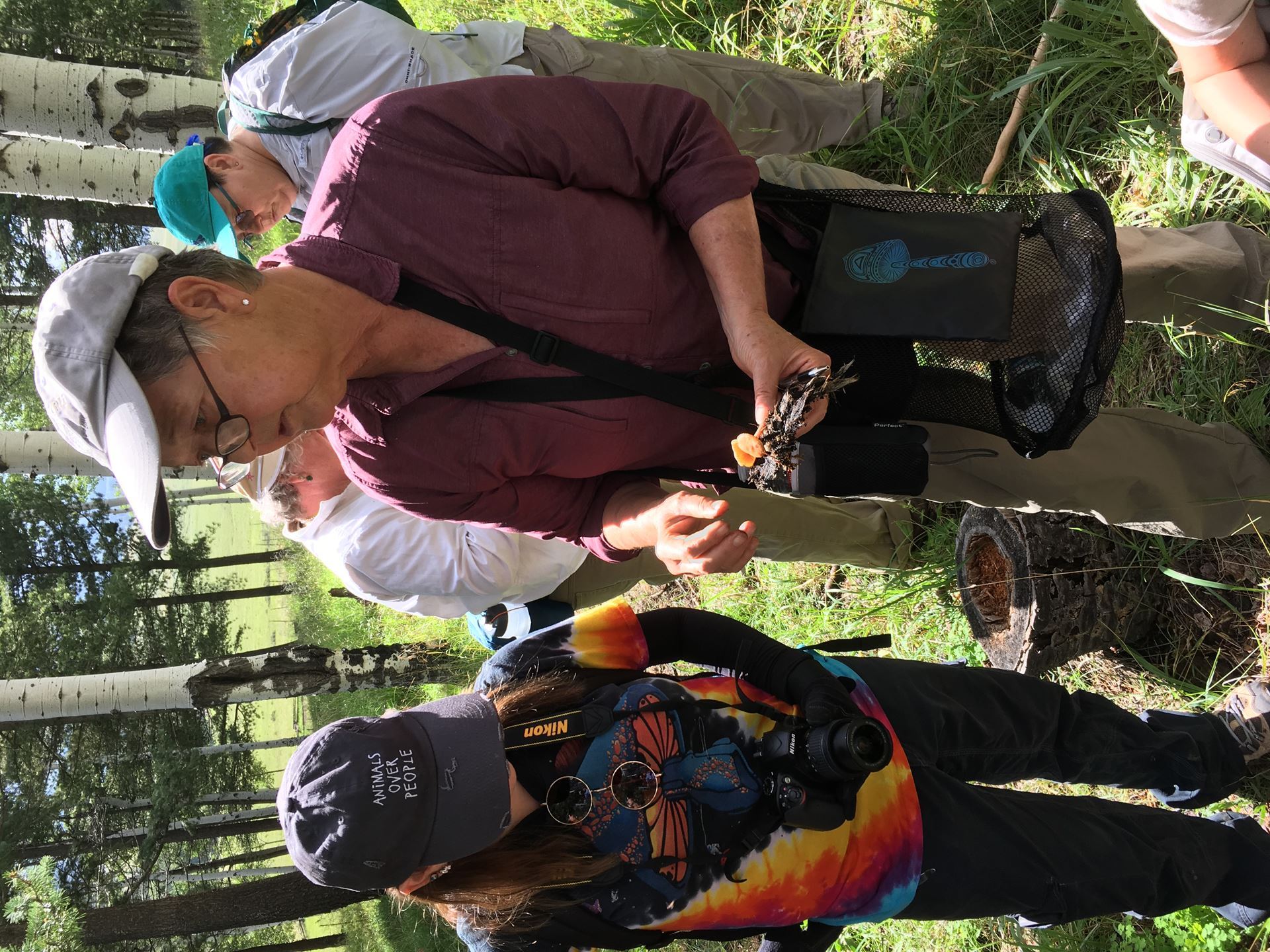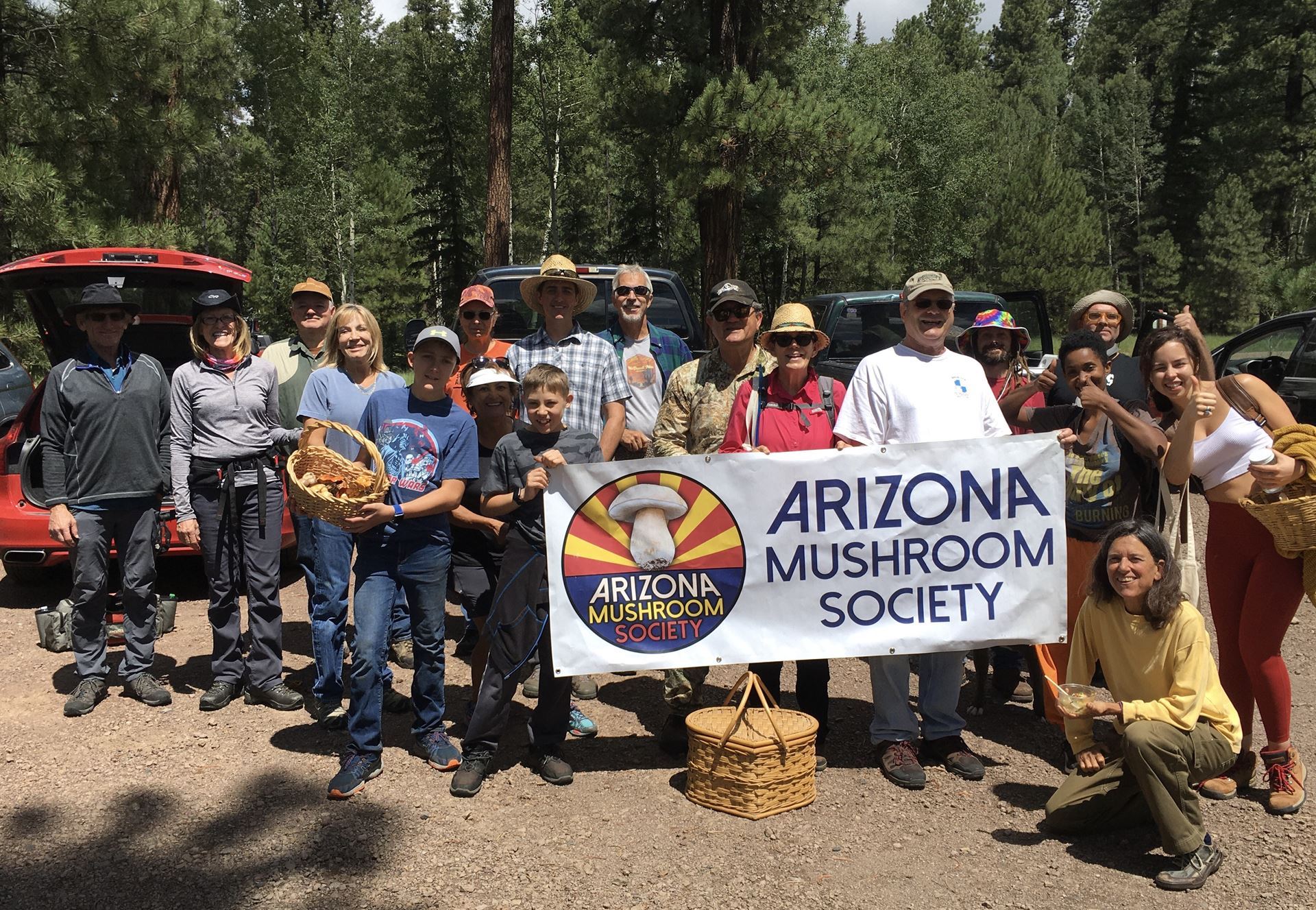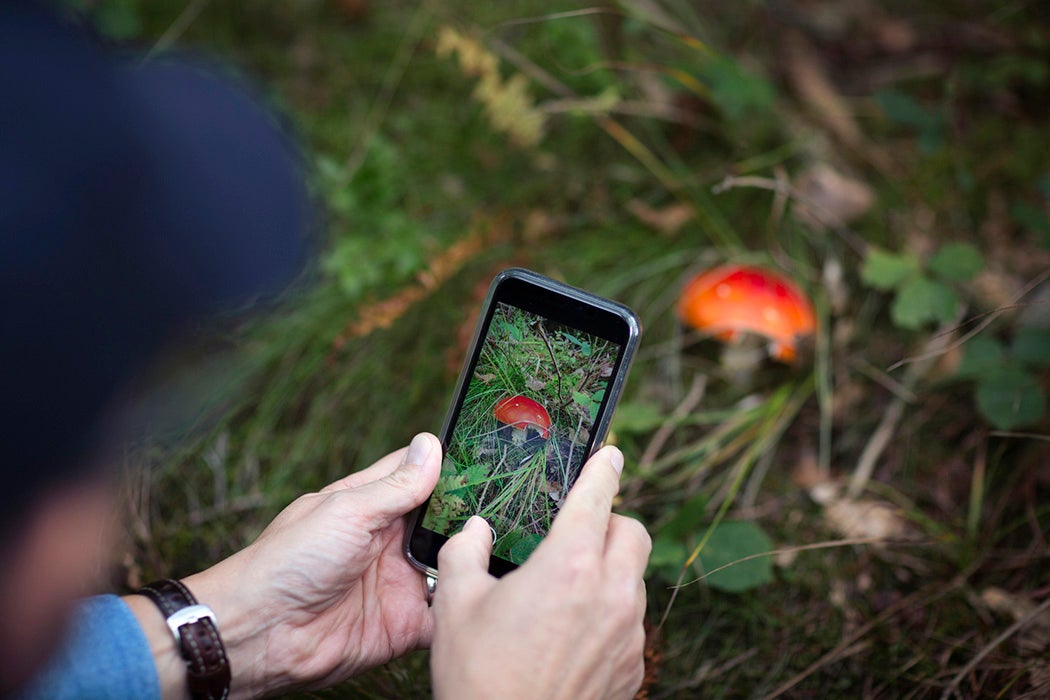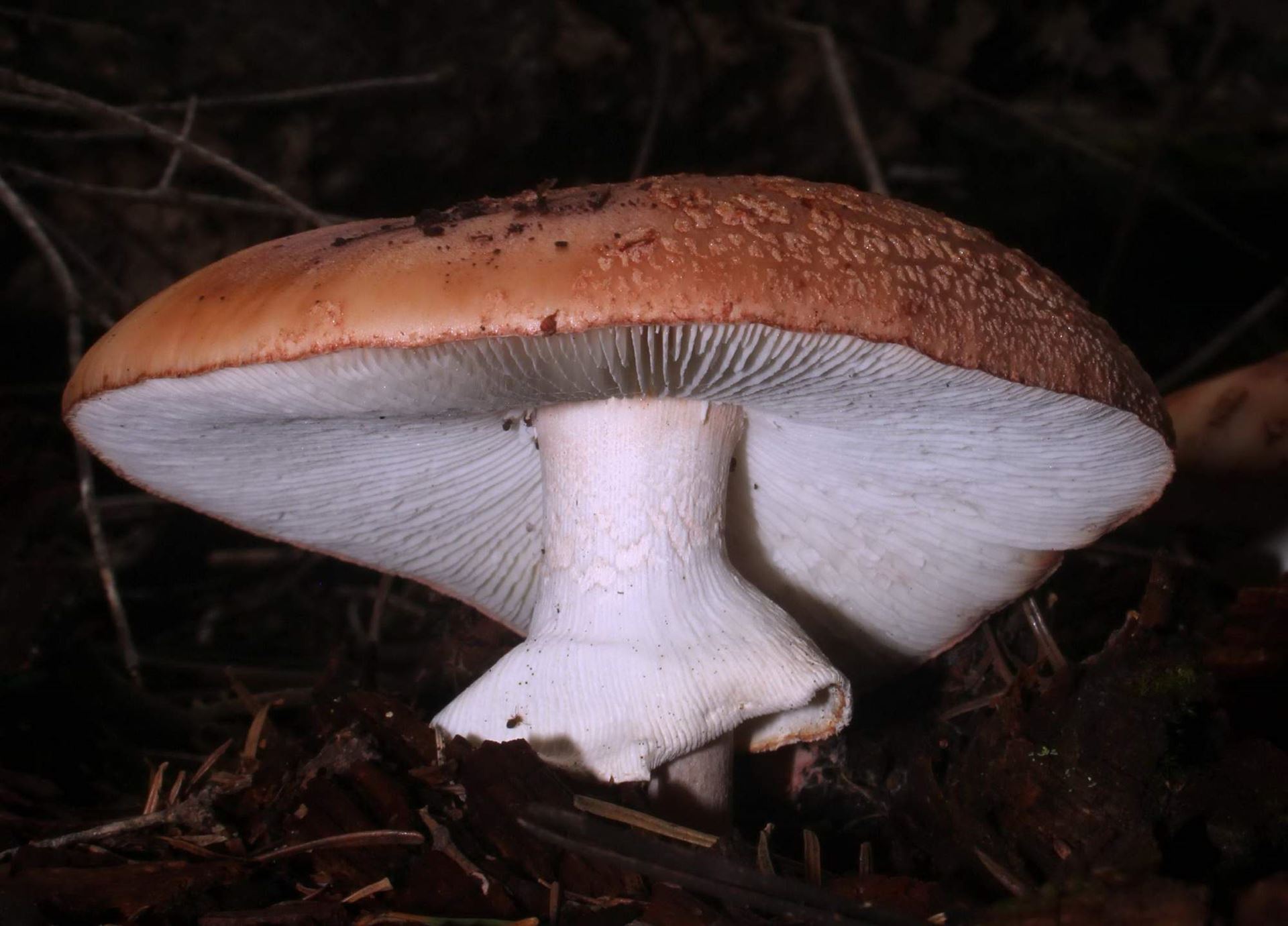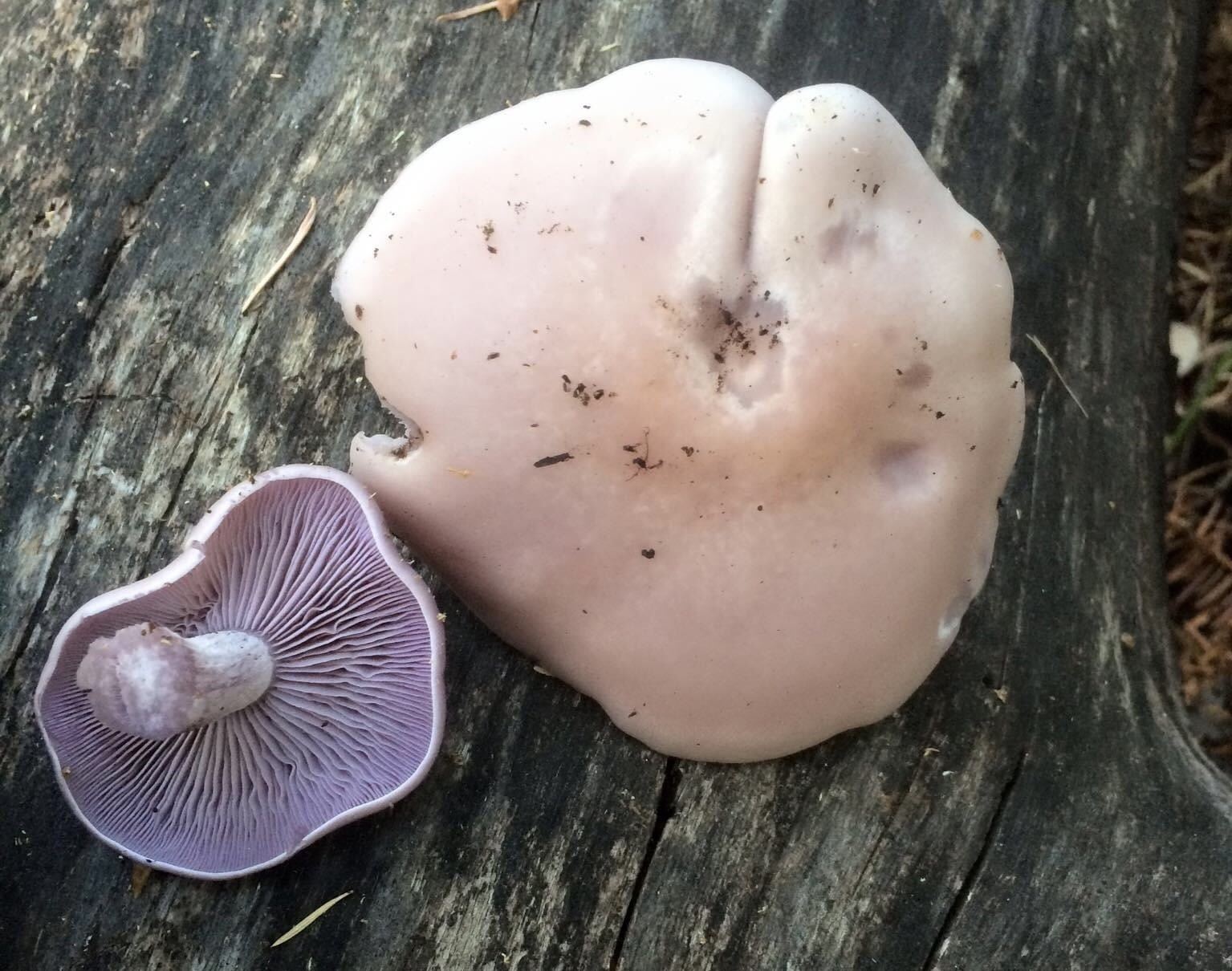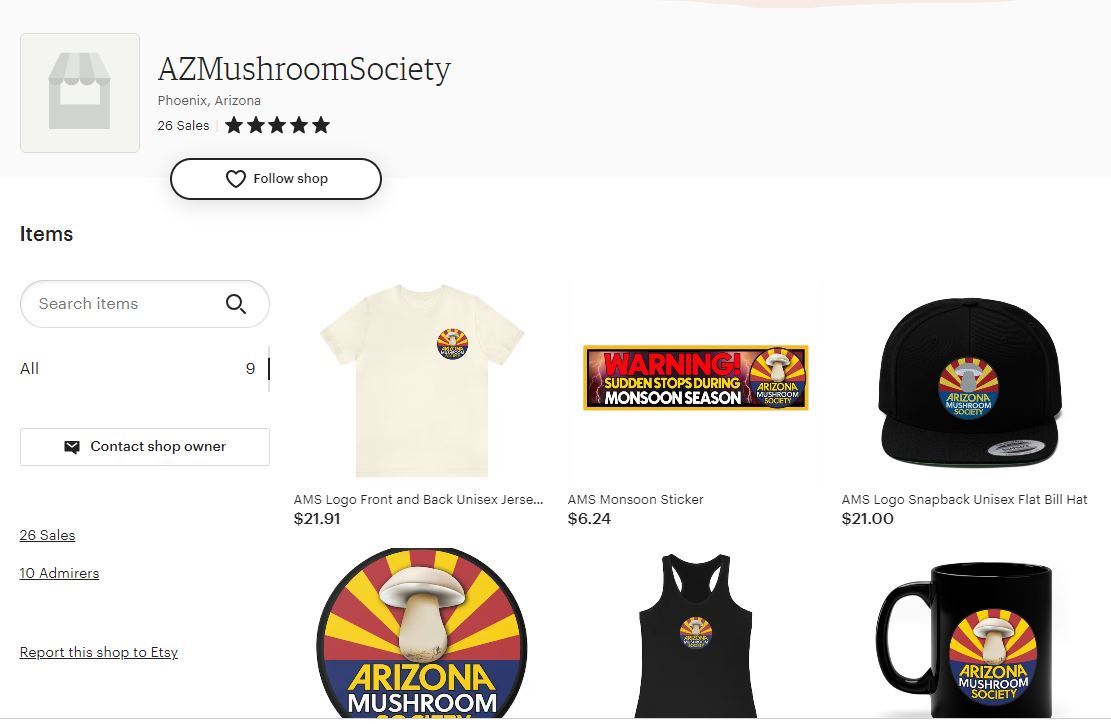J.A.M.S.
Journeys of The Arizona Mushroom Society
The Official Newsletter of the Arizona Mushroom Society • Vol. 4, no. 1 • July 2023
|
|
Table of Contents
|
|
2023 Arizona Mushroom Society Annual Foray
August 11-13, 2023 • Alpine, AZ
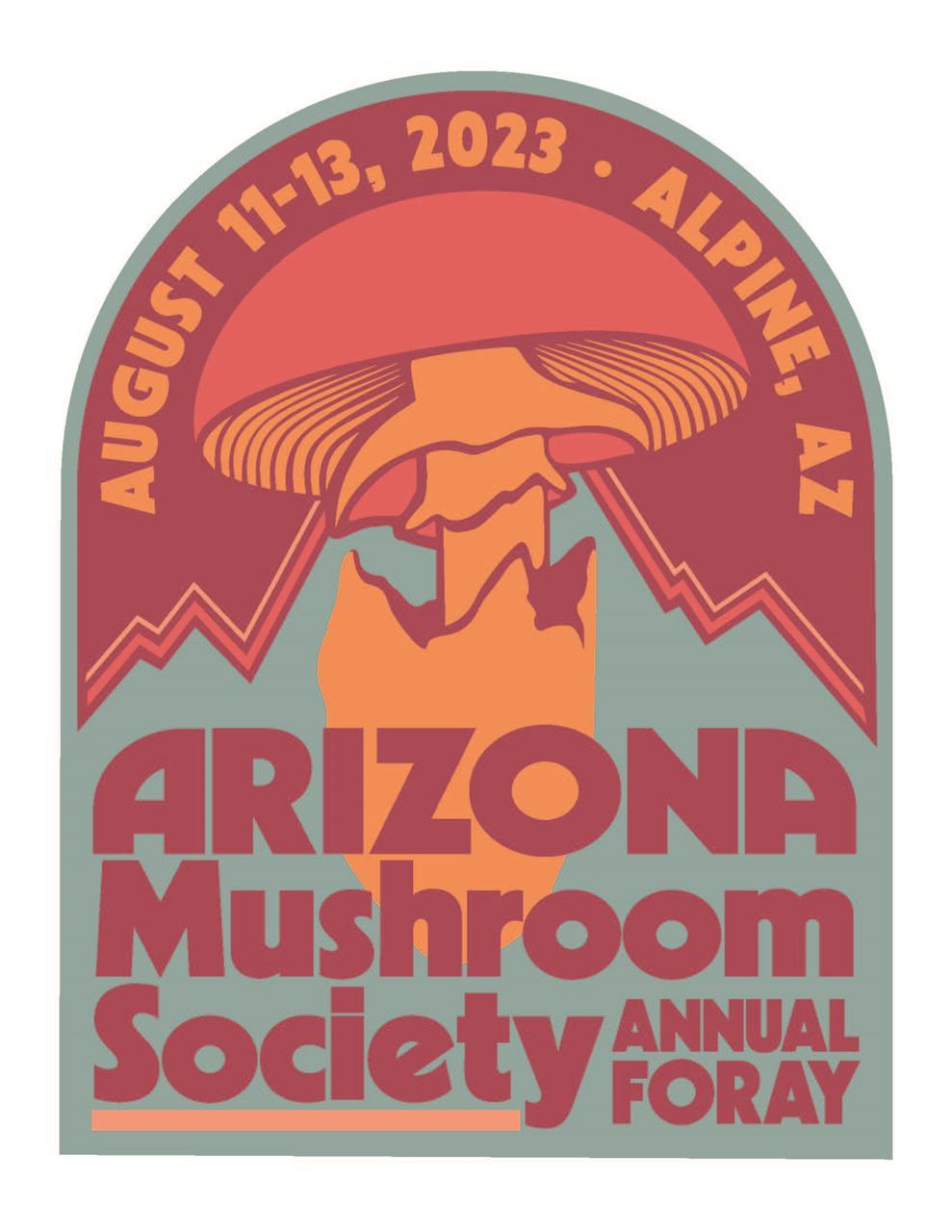
The 2023 Arizona Mushroom Society Annual Foray is planned for August 11-13, 2023 in Alpine, Arizona. The event is focused around small group wild mushroom forays led by volunteer expert mushroom hunters to help identify any fungi you can find. There are both morning and afternoon guided forays occurring throughout the White Mountains on Friday, Saturday, and Sunday (afternoon only) throughout the weekend.
Registration is open now to sign up for a foray, make a reservation for the Annual Foray Dinner, and buy a limited edition 2023 Annual Foray commemorative t-shirt! Evening activities include a Mushroom Social with fungi focused vendors and mushroom tastings on the evening of Friday, August 11, 2023. On Saturday evening we will be hosting our Annual Foray Dinner and our Keynote Presentation.
Our special guest is mycologist Else Vallinga! Else is a mycological researcher and professor with the Bruns Laboratory at UC Berkeley where she focuses on parasol mushrooms. She received her PhD at the University of Leiden in the Netherlands, and worked with the national herbarium in the Netherlands. She specializes in taxonimic work and has identified dozens of species, which is essential for the ultimate conservation of fungal biodiversity.
Else will be presenting the keynote presentation on Saturday, August 12th at 7pm. She will be presenting on spores - where they are formed, how they are spread and where they want to end up. We’ll see why some spores are colored or textured and other fascinating facts about fungi. The presentation is free and will be at the Alpine Community Center. Be sure to join us! |
AMS Hats will be available for $20 cash only on Friday and Saturday evenings at the Alpine Community center.
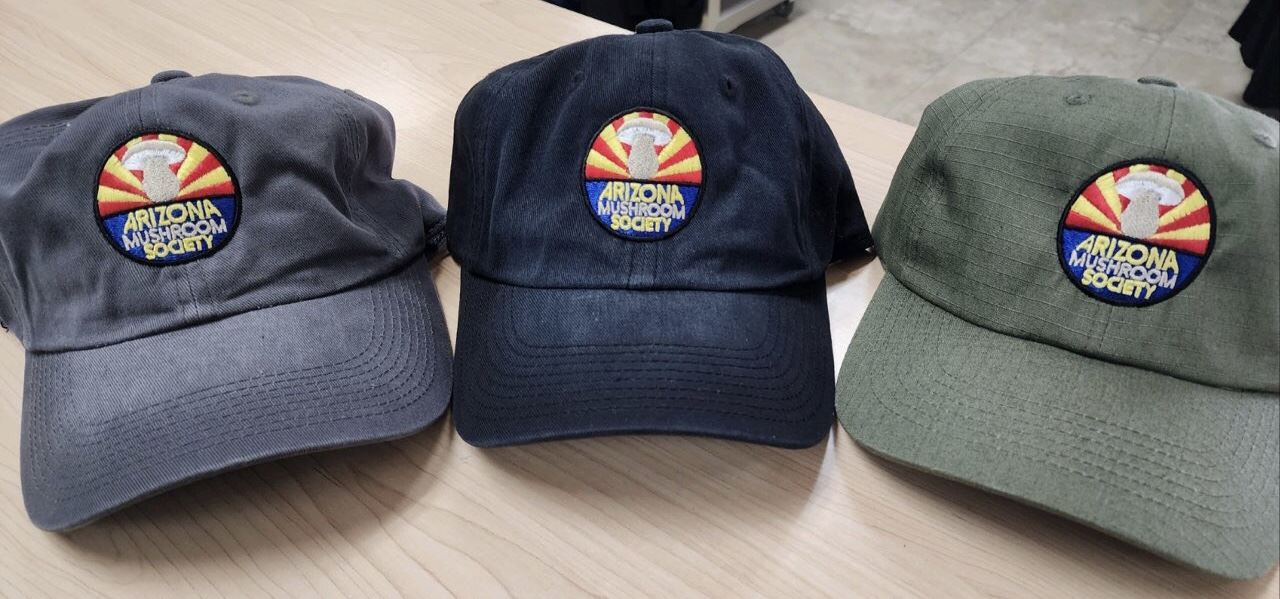
Social Media Tools for Fungi Fans by Hunter Kerlek |
The 21st century has allowed mycophiles to learn and share knowledge in a variety of ways, from podcasts to instant identification and even learning how to cultivate mushrooms, all within seconds and for the most part free. The limit is one’s mind, really, and this can be difficult to remember sometimes. If you don’t know about an app that could upgrade your next foraging expedition, how could you find it? Luckily, one can Google key words and start to make a more informed decision, or, through word-of-mouth, people can talk about what they liked or didn’t care for with certain platforms. Of course, one can lean on their local mushroom society to lay them out as well. For example, I’ve been introduced to the app Avenza Maps and have been impressed with the multi-layered approach the designers have created. I should first say that this app is for people who know how to read a map (and not just Google Maps). Avenza Maps allows you to import custom maps or download some from the over one million maps in their store so as to transverse the land in many unique ways! It is free for users who download and use maps available on the Avenza store. The Arizona Mushroom Society has taken advantage of the free App and supplied over 40 free maps of local fires on Avenza Maps to supply us fungal fanatics with knowledge on where we might be able to find burn morels. It should be noted that there is no map on Avenza Maps of exact pinpoints of where to find burn morels; rather, the many burn maps available show recent areas burned in a wildfire with potential morel habitat. When searching for maps, one can go beyond foraging and look for where to hunt, places to camp, trails to ski, and there’s even maps of different cities around the world and different touristy things to do there. Attention hikers: Avenza Maps is perfect for you! You can find specific trail heads and track exactly where you’ve been, your speed, elevation, all that good stuff. Once downloaded, you can access the map offline, which is always a plus! Maps range from free to over $100 (although most are under $5) and come in a variety of languages, you just have to sort out what it is you want and, if you can’t find it for free, then weigh out the cost to see if it is worth it to you. | If you’re like me (and if you’re reading this, you probably are) then you’ve listened to different podcasts and have searched the web for anything biology related. Therefore, you’ve probably at least heard of iNaturalist. This app is great for those who wish to be citizen scientists, for the data on here is used scientifically to log sightings and estimate abundance. There are projects on the app that you can get involved with that use this data, which can go on to possibly be used to help conservation efforts, for educational purposes, and more. For example, the AMS establishes an iNaturalist project for each AMS Foray, which allows for any foray participant to contribute to the recorded species list of fungi observed during the event. In addition to iNaturalist being a key tool for the citizen scientist, this app excels at identification. If you don’t know what that flora, fauna, or funga is on your hike or even in your backyard, you can take a picture (preferably multiple!) of the organism and upload it onto iNaturalist. I uploaded a picture of the desert shaggy mane Podaxis pistillaris and the app immediately identified it. This isn’t always the case; sometimes you have to wait until someone else IDs your picture, which it should be noted that other people are making an educated guess based off your pictures. Yet, it also should be known that our most knowledgeable mycologists and amateur mycologists in Arizona and surrounding areas regularly identify fungi posted in the app. This helps make it a great tool for learning about your surroundings based on others with intimate knowledge of the area. I went morel hunting up in Clarkdale, AZ back in April, and although the mushroom search was unsuccessful, with the use of iNaturalist the forage proved bountiful. I was able to use the Explore feature and see what was around me. What would’ve been a disappointing mushroom hunt, albeit a pleasant stroll around a river, turned into an epic learning adventure that allowed me to harvest Palmer’s Amaranth to eat and Mullein for medicine. For anyone wanting to forage or hunt a specific species in any given area, iNaturalist is just the app for them. Once identified, the Wikipedia page uploads with it, so take that with a grain of salt and do your own research of the organism. When submitting a species, you have the option of making it private, which can come in handy for endangered-yet-sought-out species or to keep your mushroom spots a secret from fellow foragers but still accessible to science! The picture’s date and the species’ seasonality are also posted, which helps immensely when it comes to the question of when to forage. | Aside from apps, there are plenty of great forums out there to help with IDing, growing, hiking, and so much more. The Facebook group Fungal Materials & Biofabrication is extremely interesting for anyone wanting to design a canoe, a chair, flowerpots, or even a guitar out of mycelium. I saw a post that asked about constructing with bioluminescent fungi and people commenting on their experiences! The Cordyceps Cultivation Group on Facebook has helped me tremendously in my path to growing Cordyceps. The people are so friendly to any questions and the posts of people’s yields are very motivating! As an avid fermenter, I follow many fermentation groups, especially (but not exclusively) Fermentation: Recipes, Ideas, Inspiration. The name alone lifts my spirits, but this is an extremely useful group to learn how to utilize fungi and bacteria in unique and healthy ways. For those wishing to forage at the tops of the sky islands down in Tucson or know what mushrooms are in season below the valley, Southern Arizona Mushroom Society is a great Facebook group to rummage through. This forum can help you know that morels have been spotted in the Santa Rita Mountains in April or that Mt Lemmon is inaccessible due to a fire. You can keep up to date with local events going on, such as foraging events and educational zoom meetings. You can learn about many a mushrooms or post one from your backyard for identification. Despite a pretty specific name for a group, you still will read about bioluminescent mushrooms in Bosnia or about the mushroom street in Alicante, Spain. Nevertheless, this is a pretty good Facebook group to join if you want to go mushroom hunting in the Tucson area. Again, the sky and your mind are the limit. What are you interested in? What do you want to learn about? Just like how there’s a mushroom for that, there’s probably an app or a social media group for that.
|
Fungi Favorites |
We like to take a moment in each newsletter to highlight a couple fungi favorites for our readers. These could be rare fungal finds in Arizona or unique and especially interesting fungi due to a key characteristic such as toxicity or life history strategy. This edition, we want to talk about two edible and generally common fungi that you might run into this year!
Lepista Nuda Lepista nuda, also known as Clitocybe nuda, or as some people simply say “blewits”, grow both in natural habitats (in AZ cypress duff in Sedona and mixed conifers and aspen in the mountains) as well as seems to thrive in other non-natural environments, like compost piles. This shows it is more of a generalist, and as such it often can have a good amount of phenotypic variability which can make them difficult to ID... especially given their poisonous Cortinarius look alike that grow in similar regions. In Cortinarius, you’ll find a rusty color on the stem due to the rusty color spores it produces. They also tend to be slimy. Blewits tend to have a whitish-pinkish spore print and are never slimy. Of course, when in doubt, leave it behind!
Some cool facts about L. nuda are that they have been known to consume bacteria colonies for their nutrients as well as satin bowerbirds, which collect blue materials for their nests, have been spotted collecting blewits for their nests, which may be a natural antibiotic for their young! | Ganoderma Tsugae
Ganoderma tsugae is a beautiful Ganoderma species or "Reishi" that is a saprobe and parasite found almost exclusively on hemlock, which is where it gets its name (Tsuga is the Genus for hemlock). It is extremely well known as a medicinal mushroom, yet not many Arizonians know that it grows in our beautiful state, most often on Douglas fir trees. The reishi mushroom has been sought out for millennia for their medicinal benefits. This preventative powerhouse has been shown to be anti-tumorigenic, antioxidant, and have immunomodulatory effects, which make it an indispensable fungi to have in your medicine cabinet or kitchen at home. It seems to grow largely in the White Mountains and in the sky islands, yet surprisingly hasn't been found much in northern AZ. It is another one of those mushroom mysteries that you can fairly reliably find reishi on Mt Lemmon or even the Mogollon Rim, but they are absent from the San Francisco Peaks and all similar mountains with Douglas fir habitat to the north. |
AMS Merchandise Now Available Online! Thanks to AMS Board Members Mike Colosimo and Jess Starwood, we are pleased to announce an all new merchandise line up on Etsy!We currently have shirts, cups, pins, bumper stickers, knit caps, AND MORE! Please visit this link for our Etsy storefront or search for "AZMushroomSociety" on Etsy. |
Book Review: Hidden Kingdom of Fungi, by Keith Seifert
Review by Mike Dechter
With fungi capturing the imaginations of more and more people and spreading like mycelium threads throughout our shared culture, the category of “fungi literature” has recently become a thing. Recent publications from Merlin Sheldrake’s Entangled Life to Jess Starwood’s Mushroom Wanderland and even Aliya Whiteley’s The Secret Lives of Fungi have gone beyond the field guide for fungi identification, or cultivation primer for growing mushrooms. These books focus more on reveling in the unique attributes of various fungi and their promise and potential for improving our everyday lives and our relationship with nature. As fungi educator these publications have been great off-season reads. They can provide unique perspectives on fungi and often interesting facts or allegories that may be useful for sharing in an educational context. So, when given the opportunity to read a copy of The Hidden Kingdom of Fungi by past president of the International Mycological Association and executive editor of Mycologia, Keith Seifert, I went for it. Having recently read the aforementioned “fungi literature”, I found Seifert’s approach both consistent with the “future is fungal” message in similar books, but also refreshingly down to earth in comparison. Seifert’s tone and writing style takes you through a tour of the fungal kingdom where the museum is made up of settings in your normal life. As you come across household molds or a tree-slaying honey mushroom at the local park, he shares poignant and interesting information about the history, significance and uses, human health ties, and biological life histories of these fungi. | Seifert’s style is antithetical to the fantastical presentation and far-off settings in other fungi literature, which both makes the material and fungi themselves more relatable. For example, the Hidden Kingdom joins us on a stroll through settings we live and work in everyday and shares information on fungi in our food (fermentation), in our farms and fields (crop symbionts and diseases), in/on our body (disease and infection), in our house (wood rot and mold), and in our local parks and forests. Much like a practiced tour guide, Seifert shares stories about esoteric fungi that everyone can relate to and then spouts off interesting information about the fungi such as a practiced tour guide might about a recently presented attraction. A perfect example of his relatable approach and information heavy follow-through is evident when he shares with us about his occasional bouts of athlete’s foot, which he endearingly refers to as his “pet fungus on my feet”, | and then continues to explain the fungal agent that causes the infection, it’s life history, and how it uses human customs to persist and spread. Hidden Kingdom is valuable because it is an easy, comfortable, and often interesting read about a vast and bewildering subject. Seifert weaves in his personal experiences and anecdotes to makes the out-of-sight world of fungi more relatable and brings hopelessly indecipherable fuzzy molds into focus for us and how they affect our lives. This effect is informative, but not always engaging. While Sheldrake may inspire, and Starwood may enchant, Seifert aims to inform. And inform he does, in a relatable way like a casual encyclopedia of fungi, complete with an extensive notes section. Unlike most other books in the fungi literature genre, the book is more fact and story based than aesthetic, lacking any photos or figures. Hidden Kingdom affirms there is great promise in areas of DNA sequencing, citizen science, and myco-technology in contributing to living healthy and sustainable lives in the future, but stops there. It lacks information regarding who is working on these important advances and how one can engage in these efforts to be part of that sustainable future. Seifert’s vast experience and friendly writing provides for a good read for anyone interested in learning a broad range of information about fungi that occur in every part of our everyday life. Reading this book is like taking a tour through a museum made up of the fungi kingdom with Seifert as your extensively knowledgeable and relatable tour guide sharing about the hidden fungi while they are kept securely behind their glass cases. Should you like to take the tour, you can find it online: https://greystonebooks.com/products/the-hidden-kingdom-of-fungi?_pos=1&_sid=4d6b2c8b7&_ss=r |
AMS Membership Costs to Increase in 2024!
On Monday, December 12, 2022 the Arizona Mushroom Society Board of Directors voted unanimously to raise the annual membership costs for individuals and families from $15/year to $25/year. The change in membership costs will take place starting January 1, 2024.
The decision to raise the annual membership cost was based on sudden increases in active members in the organization in the last few years and based on a benchmarking study that compared membership costs amongst similar organizations. The annual membership cost has remained the same since the organization was incorporated. During that timeframe, membership increased by over a factor of 10, which has resulted in greater costs and a need for more capacity to address operational limits. A look at similar mycological organizations throughout the west showed us that the Arizona Mushroom Society had the lowest membership costs of all of them at $15/year. Our neighboring mycological clubs have membership costs on par with the approved $25/year cost.
It's our hope that this change will allow us to better serve our members and improve fungi educational efforts throughout the State.
